How to Set a Table
I have been asked may times by friends hosting their first dinner party for quick tips on how to set a table. We all have the basics down, forks on the left, knife on the right. It’s when the meal becomes more formal and more complicated that we need to think about what all is going on our table and where it should be placed. I will move left to right across the table giving you my thoughts and the rules that are pretty much agreed upon by etiquette experts (I reviewed rules from Emily Post, Martha Stewart, and the Betty Crocker Cookbook). These tips also come in handy at that once in a blue moon meal in an very formal restaurant. One particular dinner I enjoyed in the formal dining room at the Breakers Hotel in Palm Beach, FL comes to mind, I think we had 6 forks. I can’t recall what we ate or drank but the service and table setting I will always remember as gracious and flawless.
- This is about the most elaborate table I can envision for an at home meal.
- Wine Glasses
- Plate
- Left Side of Plate
- Right Side of Plate
Salad Plate and Bread Plate
I love salad bowls especially for holiday family dinners where guests tend to overfill the dinner plate, give them a bowl to put salad in it will keep the salad dressing from interfering with all the other great things on their plates. If you are serving courses, with salad first you can move a salad bowl to the center of the dinner plate indicating it is to be eaten first. It is rare to see this formal first course salad service at home but if your main dish is taking longer to cook than you thought, seat your guest for a first salad course while your roast gets 15 more minutes in the oven, don’t forget to clear the salad bowls when you go back to the kitchen to get the main course.
Above the salad bowl you can have a bread plate. The butter knife, if you have one for each place, should go with the blade facing left on the bread plate. At a lot of large events (weddings) you will see bread and/or butter already on these plates before people sit down, I am not a fan of setting bread out to get stale but if you have guests that might find passing the bread basket a chore go for it. But please refrain from buying a butter mold to make those silly butter flowers that hotels insist on loading on the bread plates. If you have chosen to have a first course salad I would pass the bread the first time when the salad is served, and then again when dinner is served. Leave the bread basket and bread plates on the table for with dinner, no need to clear them with the salad plates.
Forks and Desert Flatware
Dinner forks are pretty simple, the one you will use first goes to the outside, then one fork for each subsequent course moving toward the plate. Most of the time that will mean smallest fork outside biggest next to the dinner plate. I set my example table with just a dinner and salad fork, but you may also need to include fish forks or other flatware here if you have additional courses. The bottom of the forks, edge of the dinner plate and bottom of the knifes should all be about 1 inch from the edge of the table. Don’t crowd your forks to close to either the dinner or bread plates, that can be cumbersome for guests. If the center of the dinner plate is being used to serve a salad or other first course the napkin can be folded and placed under the forks.
The space above the plate is normally reserved for a coffee spoon and desert fork always with the handle on the right, so it is easy for a right handed person to pick up and use, sorry lefties. There are a lot less rules about what can go above the plate, so if you need to find a place for the crab claw crackers or fondue forks here is a good place to put them, and then just deliver the desert flatware at the end of the meal.
Dinner Plate
The Dinner plate with the napkin in the center should be placed about one inch or two finger widths, from the edge of the table. If you are placing the plate on a charger then measure from the bottom of the charger to the table’s edge. Napkins in the center of the dinner plate are traditional and help remind people to put their napkin on their laps. If you want to serve a composed salad, soup, or amuse-bouche as a first course, prepare each individual serving in the kitchen or ladle the soup at the table, then place the first course bowl/plate in the center of the dinner plate. The napkin will move to under the forks on the left. Ideally if you have served the first course in the center of the dinner plate the first course bowl/plate should be clearer from the table when the next course is brought out. I recommend accomplishing this feat by using a large sturdy tray.
Knifes and Spoons
The knifes and spoons will be placed on the right of the plate with the ones you will use first farthest from the dinner plate, just like the forks. The bottom of the cutlery should be about one inch from the table’s edge. I have set my example place with a teaspoon, soup spoon, table knife and steak knife. Most of the time a soup spoon will not be needed and for a less formal meal I might only supply either a steak knife or table knife. I always supply a teaspoon no matter the meal, I just think the table looks unbalanced to leave it off, and the experts appear to agree. I will include a soup spoon at any meal that I serve a long pasta for people that twirl pasta, and for lunches with ice tea I will provide an ice tea spoon either farthest to the right of all the spoons or above the dinner plate.
Wine and Water Glasses
The first glass to be used, normally the water glass, is above the inner most knife. The wine glasses then are arranged outward from there to the right. This table has a water goblet, champagne flute, white wine glass, and red wine glass. Four wine glasses will be overkill for most at home meals, normally water and either one or two wine glasses should be enough. Many people opt for a single all-purpose (red or white) wine glass and one water goblet then serve red and white wine through the whole meal allowing each guest their preference. In a perfect world where we have staff to work at our dinner parties the empty wine glasses would be removed at the end of the corresponding course, thus only the water and red wine would be on the table at the end of the meal. For a lunch or brunch I might forgo the stemware in favor of regular rocks and/or highball glasses but the order would be the same water then ice tea moving away from the plate.
Tea, Coffee and Desert
I did not include a tea or coffee cup and saucer on this table setting but if you want to place it on the table for the whole meal it would go below the wine glasses and to the right and slightly above the last spoon. I normally will not put coffee or tea cups on the table, it is just too crowded. It is correct to clear away all items not in use for desert after dinner, so plates, glasses even the salt and pepper all should go to the kitchen.
I deliver the desert, desert plates, and desert flatware (if not above the dinner plate) at the end of the meal, another good time to use that big tray and do it all in one trip. I will also work off a dinning room sideboard table to stage the desert course if that is convenient.


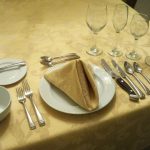
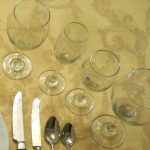
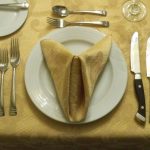
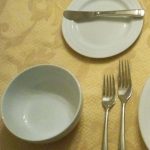





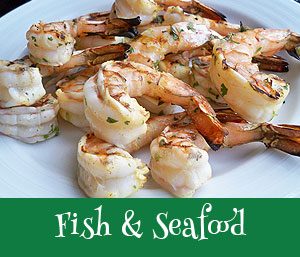
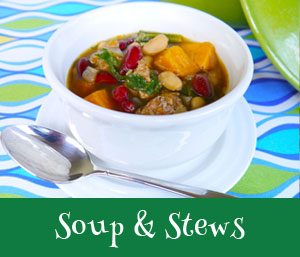
Reblogged this on lesley-anne pittard and commented:
Everyone must learn how to do this. Absolutely critical!
I have to admit a mistake on my photos, the soup and tea spoons are reversed unless I am serving a meal in which the soup is not a first course. Next time I set the table for a big dinner party, I will try to remember to re shoot these photos. Sorry about that error.